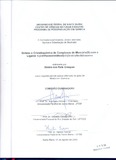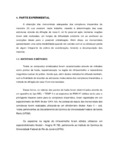| dc.creator | Crespan, Estela dos Reis | |
| dc.date.accessioned | 2017-05-15 | |
| dc.date.available | 2017-05-15 | |
| dc.date.issued | 2005-08-01 | |
| dc.identifier.citation | CRESPAN, Estela dos Reis. Synthesis and crystallochemistry of mercury(ii) complexes with ligand 1-(3-trifluoromethylphenil)-3- (3-nitrophenil)triazene. 2005. 91 f. Dissertação (Mestrado em Química) - Universidade Federal de Santa Maria, Santa Maria, 2005. | por |
| dc.identifier.uri | http://repositorio.ufsm.br/handle/1/10534 | |
| dc.description.abstract | This work shows the crystaline/molecular structure of two mercury(II) complexes with a same monocateneted triazene ligand previolsly deprotonated. The reaction between mercury(II) acetate, 1-(3-nitrophenyl)-3-(3-trifluorometilphenyl)triazene and triphenylphosphine in a methanol of yields the complex [Hg(CF3C6H4NNNC6H4NO2)2(C18H15P)] (1). (1) cristallizes in triclinic system, space group P 1, Z = 2, with cell parameters a = 11.8334(3) Å, b = 13.7747(3) Å, c = 15.3909(4) Å, α = 75.9550(10)°, β = 70.8900(10)°, γ = 65.9750(10)°. The refinament of this estructure converges to the follow discordance indexes R1 = 0.0525 e wR2 = 0.1342. The coordination sphere of mercury(II) ion is formed by two deprotonated triazenido ligands and a triphenilphosphine molecule imposing a trigonal-distorted coordination geometry to the metallic center. Intermolecular interactions of C-H···O type are observed in this structure originating chains of molecules guided parallel to the crystallographic direction [101]. These chains for your time settle of form centrosimetric some relative ones to the other ones, forming bidimensional supramolecular arrangement binding intermolecular interactions type C-H···F. The reaction between mercury(II) acetate, 1-(3-nitrophenyl)-3-(3-
trifluorometilphenyl)triazene and pirydine in a methanol of yields the complex [Hg(CF3C6H4NNNC6H4NO2)2(C5H5N)] (2). (2) cristallizes in monoclinic system, space group P21/c, Z = 4, with cell parameters a = 13,5586(3) Å, b = 19,2937(5) Å, c = 12,9152(3) Å, β = 90,9610(10)°. The refinement of this structure converged to the discordance indexes R1 =
0,0470 and wR2 = 0,1365. The coordination sphere of mercury(II) ion is formed by two deprotonated triazenido ligands and a pyridine molecule imposing a T-distorted coordination
geometry to the metallic center. The molecular structure reveals disordered fluorine and oxygen atoms related to the the trifluoromethyl and nitro substituents, respectively. A discussion of intermolecular interactions via C-H···O and C-H···F is not possible at this stage of the structure analysis. On the other hand, the crystal structure of (2) in contrast to other examples of this class of compounds, does not present intermolecular metal-arene π interactions between the Hg(II) ion and terminal aryl substituents of the triazenide ligand. Beside the X-ray structure analysis, both the complexes (1) and (2) were also characterized by melting point determination and infrared spectroscopy. | eng |
| dc.description.sponsorship | Coordenação de Aperfeiçoamento de Pessoal de Nível Superior | |
| dc.format | application/pdf | por |
| dc.language | por | por |
| dc.publisher | Universidade Federal de Santa Maria | por |
| dc.rights | Acesso Aberto | por |
| dc.subject | Triazeno | por |
| dc.subject | Complexos triazenidos de mercúrio(II) | por |
| dc.subject | Triazene | eng |
| dc.subject | Mercury(II) triazenides complexes | eng |
| dc.title | Síntese e cristaloquímica de complexos de mercúrio(ii) com o ligante 1-(3-trifluorometilfenil)-3-(3-nitrofenil)triazeno | por |
| dc.title.alternative | Synthesis and crystallochemistry of mercury(ii) complexes with ligand 1-(3-trifluoromethylphenil)-3- (3-nitrophenil)triazene | eng |
| dc.type | Dissertação | por |
| dc.description.resumo | Este trabalho apresenta a determinação da estrutura cristalina/molecular de dois complexos de mercúrio(II) com um mesmo ligante triazeno monocatenado previamente
desprotonado. A reação entre acetato de mercúrio(II) e o ligante 1-(3-nitrofenil)-3-(3-trifluorometilfenil)triazeno e trifenilfosfina em metanol forma o complexo Hg(CF3C6H4NNNC6H4NO2)2(C18H15P)] (1). (1) cristaliza no sistema triclínico, grupo espacial P 1, Z = 2, com parâmetros de cela a = 11,8334(3) Å, b = 13,7747(3) Å, c = 15,3909(4) Å, α = 75,9550(10)°, β = 70,8900(10)°, γ = 65,9750(10)°. O refinamento desta estrutura convergiu aos índices de discordância R1 = 0,0525 e wR2 = 0,1342. A esfera de
coordenação do íon mercúrio(II) é formada por dois ligantes triazenidos desprotonados e uma molécula de trifenilfosfina, impondo uma geometria de coordenação trigonal-distorcida
ao centro metálico. Interações intermoleculares do tipo C-H···O são observadas nesta estrutura originando cadeias de moléculas orientadas paralelamente à direção cristalográfica
[101]. Estas cadeias por sua vez arranjam-se de forma centrossimétrica umas relativas às outras, formando um arranjo supramolecular bidimensional através de interações
intermoleculares do tipo C-H···F. A reação entre acetato de mercúrio(II) e o ligante 1-(3-nitrofenil)-3-(3-trifluorometilfenil)triazeno e piridina em metanol forma o complexo [Hg(CF3C6H4NNNC6H4NO2)2(C5H5N) (2). (2) cristaliza no sistema monoclínico, grupo espacial P21/c, Z = 4, com parâmetros de cela a = 13,5586(3) Å, b = 19,2937(5) Å, c =
12,9152(3) Å, β = 90,9610(10)°. O refinamento desta estrutura convergiu aos índices de discordância R1 = 0,0470 e wR2 = 0,1365. A esfera de coordenação do íon mercúrio(II) é
formada por dois ligantes triazenidos desprotonados e uma molécula de piridina, impondo uma geometria de coordenação T-distorcida ao centro metálico. A estrutura molecular revela
uma desordem dos átomos de flúor e de oxigênio dos grupos substituíntes m-trifluorometil e m-nitro, respectivamente, prejudicando uma possível discussão de interações intermoleculares secundárias do tipo C-H···O e C-H···F. Por outro lado, a estrutura cristalina de (2) em contraste com outros exemplos desta classe de combinações, não apresenta
interações intermoleculares secundárias do tipo metal-areno π incluindo o íon mercúrio(II) e átomos de carbono dos anéis fenila terminais dos ligantes triazenidos. Além da análise estrutural por difração de raios-X, ambos os complexos (1) e (2) também foram caracterizados por ponto de fusão e espectroscopia de infra-vermelho. | por |
| dc.contributor.advisor1 | Hörner, Manfredo | |
| dc.contributor.advisor1Lattes | http://buscatextual.cnpq.br/buscatextual/visualizacv.do?id=K4783542Z5 | por |
| dc.contributor.referee1 | Fenner, Herton | |
| dc.contributor.referee1Lattes | http://buscatextual.cnpq.br/buscatextual/visualizacv.do?id=K4785474Z5 | por |
| dc.creator.Lattes | http://buscatextual.cnpq.br/buscatextual/visualizacv.do?id=K4718913H7 | por |
| dc.publisher.country | BR | por |
| dc.publisher.department | Química | por |
| dc.publisher.initials | UFSM | por |
| dc.publisher.program | Programa de Pós-Graduação em Química | por |
| dc.subject.cnpq | CNPQ::CIENCIAS EXATAS E DA TERRA::QUIMICA | por |



